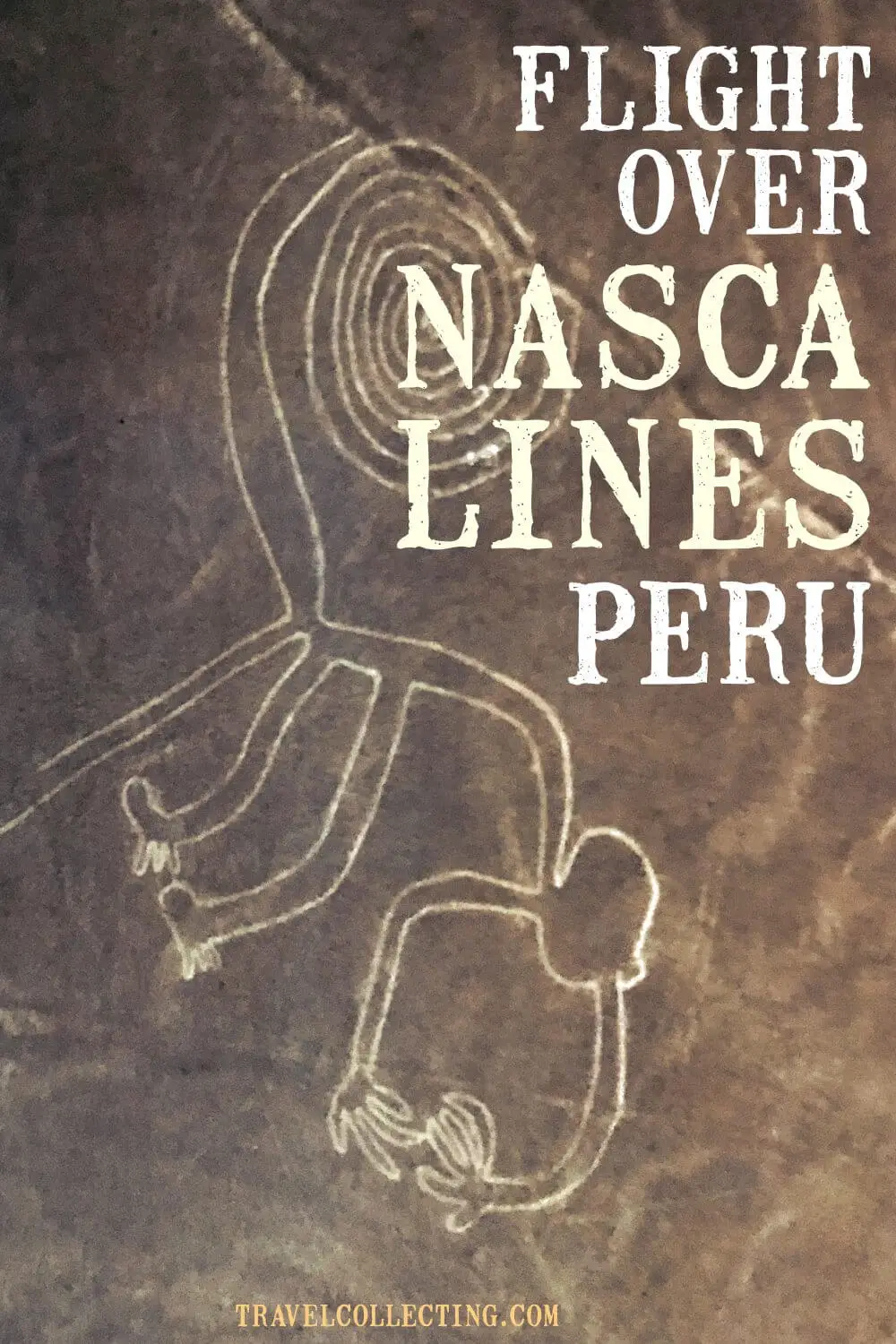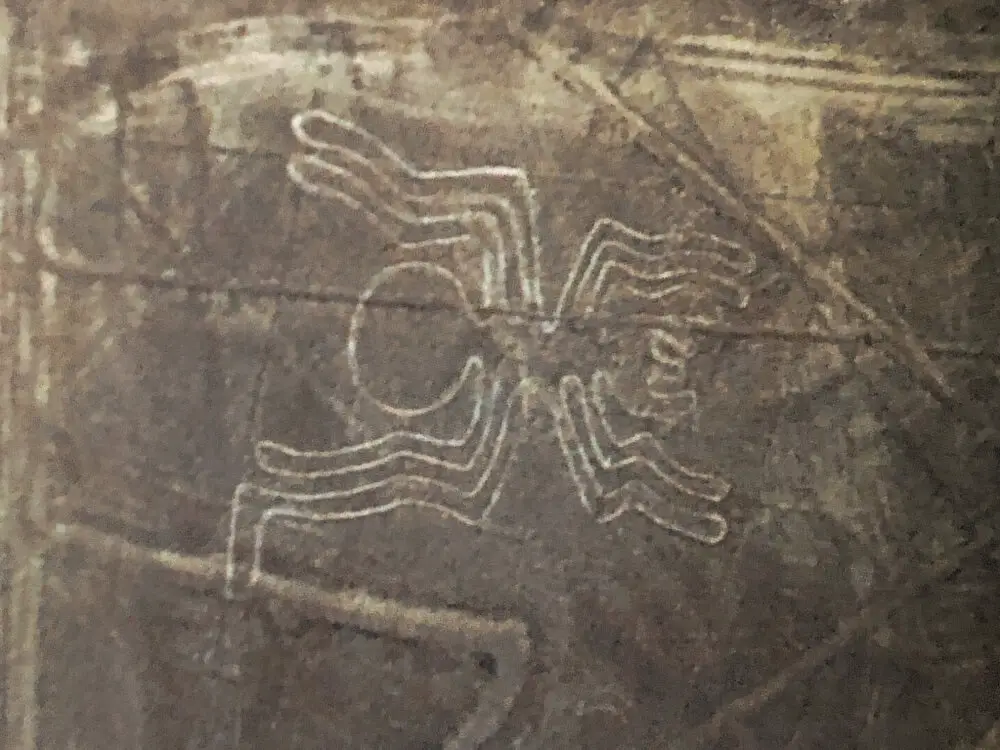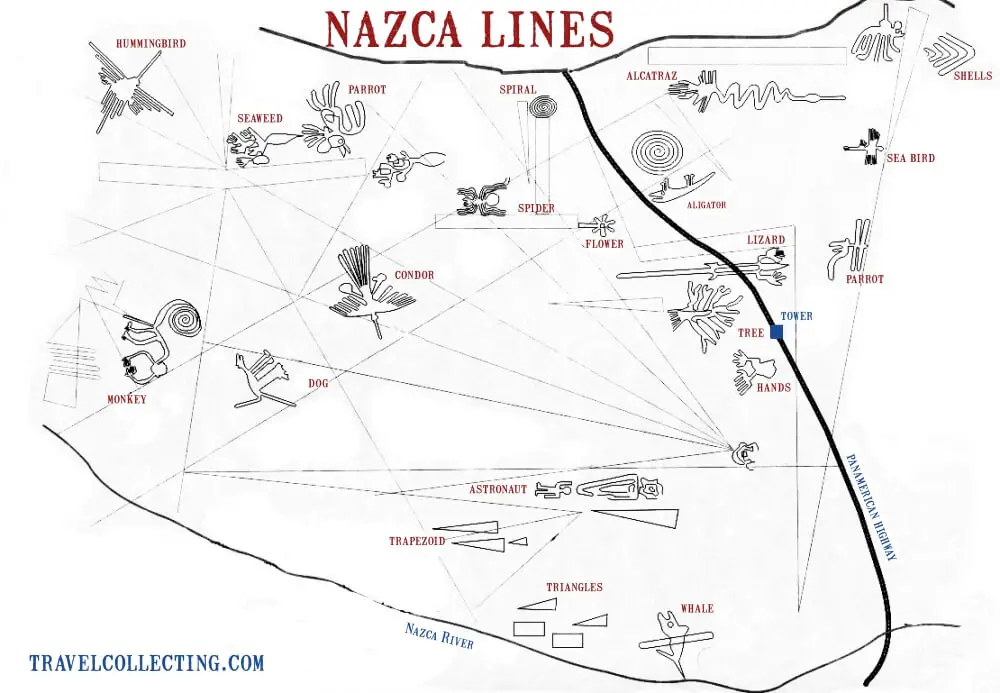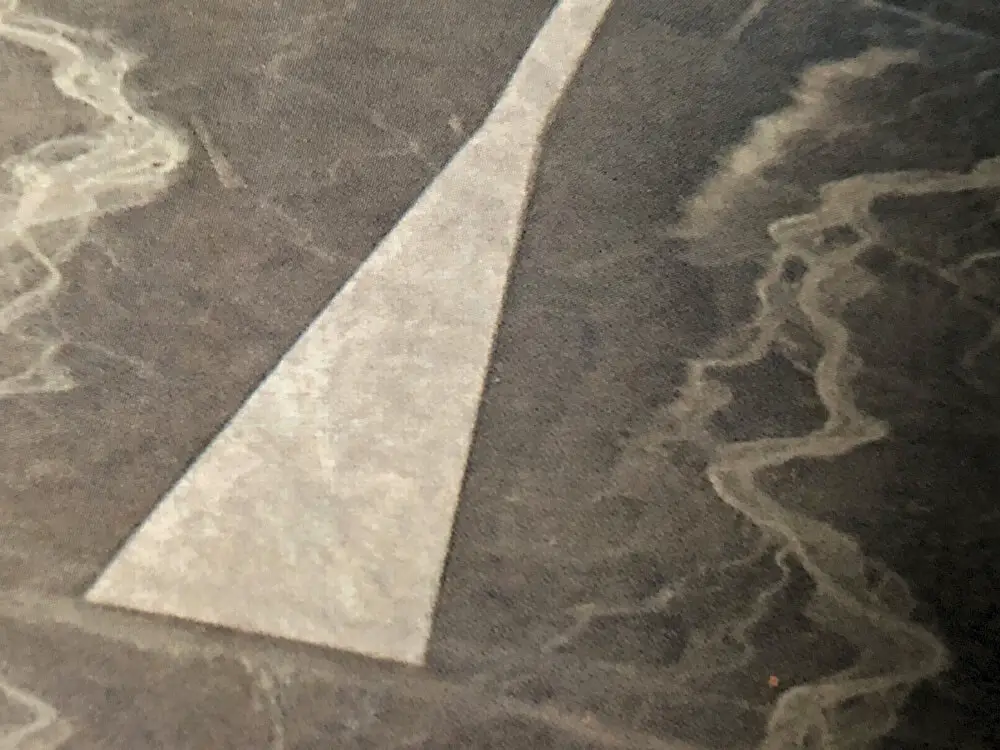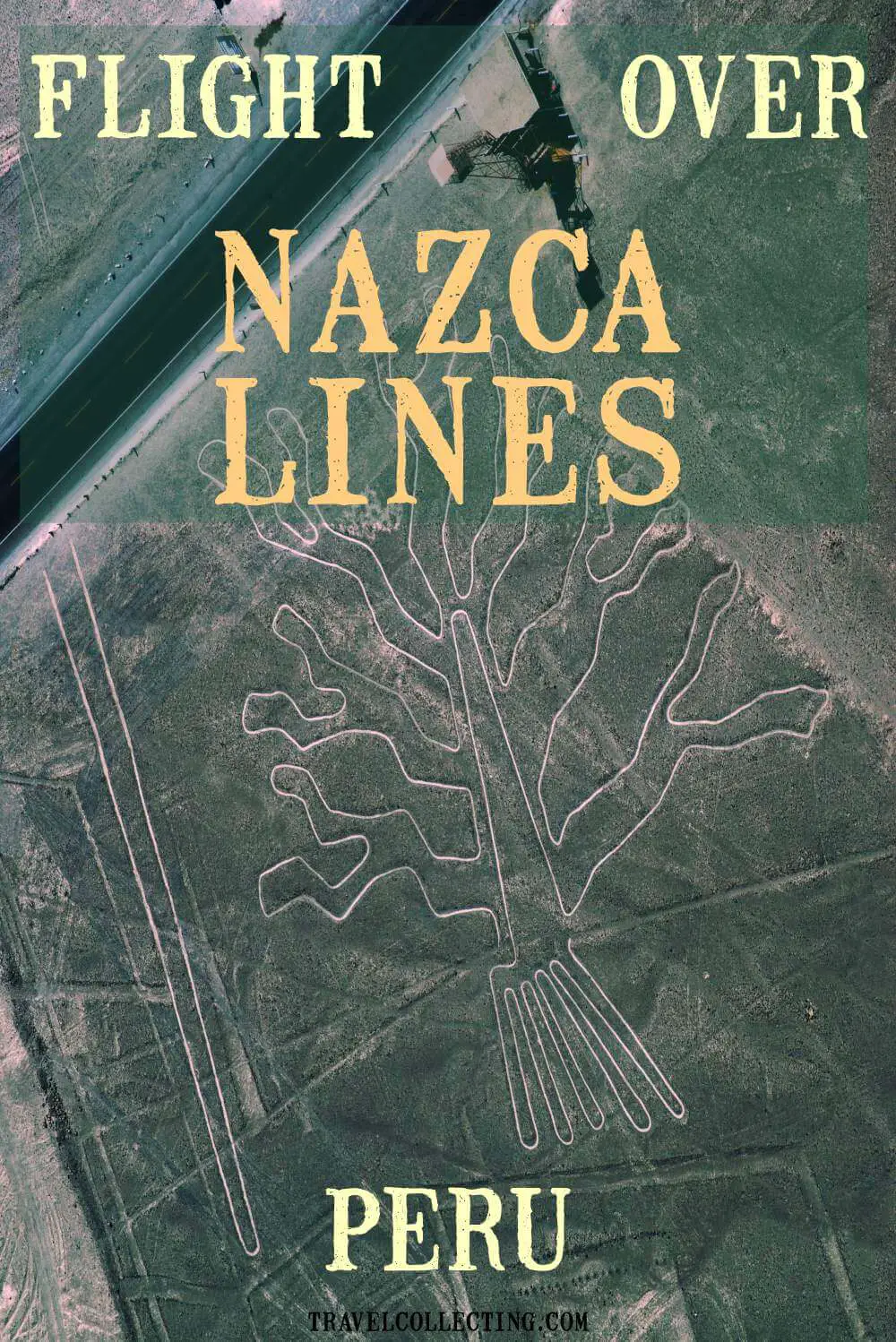I look down from the tiny plane I am in and far below is what is clearly a picture of a monkey. It has a long tail, spiraled tightly into a circle. It is surrounded by dark desert sand and some low dunes.
I am fascinated by this creature – and others like – it. Was is made by aliens? By an ancient civilization long before people could fly? How did it get here? And why?
No time right now to read about the flight over the Nazca Lines? Pin it and save it for later:
Please note this post may contain affiliate links, which means we may receive a commission, at zero cost to you, if you make a purchase through a link. Please see our full Disclosure for more information. If you have any questions, please let me know.
Nazca Lines Flight
When I visited Peru, in addition to trekking the Inca Trail to Machu Picchu and rafting the Apurimac River in the Peruvian Andes, I took a trip to Nazca.
Nazca, Perù is home to one of the world’s greatest mysteries. I remember reading about them when I was a kid and I couldn’t wait to take a flight over these mysterious desert drawings and see them first hand.
Subscribe to monthly updates with tips for planning, travel inspiration and trip ideas and get instant access to the free PDF of this
Nazca Lines Flight Guide
Seeing the Nazca lines, Peru
The flight, the top thing to do in Nasca, was in a small 6-seater (the pilot and 5 passengers), and we were picked up from our hotels and take to the nearby Nazca airport for the 30-minute flight over the Nazca lines.
How to see the Nazca lines
What is the best way to see Nazca lines? There are two types of Nazca lines trip:
- Nazca Lines Viewing Tower. The Nazca lines ground level views are not as good as from the air, but there are viewing towers available. Seeing these ancient Peruvian symbols from a Nazca Lines tower can be a supplementary experience to the flight or an alternative if you don’t like flying in small planes. And, although the views of Nazca lines from ground level aren’t as good from the air, it does give you a chance to see the Nazca lines close up.
Book a land tour of Nazca here (though you should book a flight too!)
If you don’t like flying (in a small plane), then you can book a tour of the three towers and the Maria Reiche Museum and the Cahuachi Pyramids here.
- Flights. The best way to see the Nazca lines is by plane as the Nazca lines aerial view allows you to see the shapes properly.
Flights over Nazca lines leave from Nazca airport, Peru, and transfer to the airport from your hotel in Nazca is included in the price of flights, as is a 50-minute video at the airport about the Nazca lines. There are Nazca flights leaving throughout the day.
Nazca lines flight cost starts at $100 for a 30-minute flight. Book the Nazca lines plane tour (30 minutes) here. OR book a 60-minute flight over the Nazca lines here. I did a 30-minute flight and wish I’d chosen the 60-minute option, as 30 minutes was very short and the lines are very cool.
A Nazca lines flight tour typically includes a transfer to the Nazca lines airport and the Nazca lines tour price includes both transfer and flight.
- Book a Nazca lines tour from Nazca (flight) here.
- There are a few options for a Nazca lines tour from Lima:
- Option A includes a trip to the Ballestas Islands (see pengins!). Book the Lima to Nasca lines flight tour here
- Option B is a day trip that includes a flight over the Nasca lines and a trip to the Huacachina oasis and sand dunes (which I loved). Book this day trip from Lima to Nazca and the oasis here.
- You can take a Nazca lines tour from Ica. Book the Nazca lines flight from Ica here.
- You can also take a Nazca lines tour from Pisco. Book the Pisco flight here.
- Take a flight over the Nazca Lines from Huacachina here. Book the Huacachina flight here
The Verdict: Flights over Nazca lines
This is a very cool experience. It’s amazing to me that figures, lines and geometric shapes like this that can only be seen properly from the air were made by a civilization that existed long before flight.
Subscribe to monthly updates with tips for planning, travel inspiration and trip ideas and get instant access to the free PDF of this
Nazca Lines Flight Guide
Nazca lines facts
Let’s start with what the Nazca Lines are. The Nazca lines in Peru raise a lot of questions. Here are some answers:
What are the Nazca lines?
The Nazca lines are huge drawings visible only from air. There are dozens of drawings of animals, shapes and lines that are visible most easily by air. They are technically geoglyphs.
Peru’s desert lines have been claimed by some to be evidence of aliens and that you can see the Nazca lines from space.
Others claim these mysterious lines in South America were produced by a fascinating culture two thousand years ago. Let’s look more closely at the Nazca geoglyphs.
Key Nazca figures include:
- Nazca hummingbird line drawing
- Nazca condor (the Nazca lines condor looks a little like the hummingbird)
- Nazca lines heron (sometimes called a sea bird)
- Nazca lines monkey (the Nazca monkey is one of my favorites – it has very spirally tail)
- Nazca monkey
- Nazca lines man
- Nazca lines spider (the Nazca spider is also one of the most popular geoglyphs)
- Nazca lines spiral
- Nazca lines tree (one of the three towers is right next to the tree)
Nazca lines map
Here is a Nazca map with many of the key Nazca desert lines and Nazca drawings marked.
How did the Nazca lines get there?
No one knows for sure who made the Nazca lines and there are many Nazca lines theories. One of the most prominent is that that the Nazca lines = aliens evidence and that they are welcoming signs for aliens and/ or alien landing sites.
Evidence used to support this is that among the Nazca symbols is a 150-foot/ 46-meter high Nazca lines “astronaut” on a hillside that looks more like a Nazca alien. There are several lines and trapezoid shapes that could be a Nazca runway for alien spacecraft. However, this theory is probably the least believed.
Who created the Nazca lines?
So, if they weren’t built by aliens, who built the Nazca lines? The most credible theory is that they are ritual sites built by the Nazca Indians who lived between 600BC and 700AD.
Why were the Nazca lines made?
The purpose of Nazca lines isn’t known with certainty, but it is likely that the culture of the ancient Nazca peoples included shamans who took hallucinogenic drugs from the San Pedro cactus and experienced “flights”, which is why they created designs best seen when flying.
Many of the animals featured are not from the area, but they are of significance to shamans. The plants, spiders, and birds could, for example, symbolize fertility. Shamans start their mind “flights” in a spiral, and there are several spirals among the Nazca lines.
Nazca culture was also dominated by the need for water, and they suffered a severe forty-year long drought. The straight lines and trapezoid shapes are pointing to sources of water or symbols of water sources or along energy lines.
The idea is that they were created to draw the attention of the gods above to the Nazca’s peoples’ need for water. It’s also possible that the lines were procession routes, and as the people walked along them, they stimulated energy to the water sources.
What do the Nazca lines mean?
Other theories are that are a giant calendar or an astronomical chart. A prominent astronomer, however, ran their alignments through a computer program and came up with very few significant matches to celestial bodies.
Two of them align to the sunrise at the winter and summer solstices and the spider points to Orion’s belt, which important to pre-Incan civilizations, but given that there are around 1,300 lines and only about 6 are linked to the stars, I’m inclined to disbelieve this theory.
How big are the Nazca lines?
The Nazca lines size varies. The trenches that make them are shallow – only about 4-6 inches/ 10-15 cm deep. The hummingbird measures 310 feet/ 93 m, the spider 150 feet/ 47 m, the monkey 310 feet X 190 feet/ 93 m X 58 m, and the condor 440 feet/ 134 m.
How old are the Nazca lines?
So, when were the Nazca lines made? No one knows for sure, but it is believed that most of them date from around A.D. 1 to 700.
How were the Nazca lines created?
They are geoglyphs, which are drawing made by taking away rocks and earth, which were dark as a result of oxidization, to create a “negative” image by exposing the paler unoxidized sand below.
Who discovered the Nazca lines?
The Nazca lines discovery is attributed to Toribio Mejia Xesspe, an archaeologist from Peru (although there are actually references to them much earlier in a 1553 book by the conquistador Pedro Cieza de Leon).
When were the Nazca lines discovered?
Toribio Mejia Xesspe found them in 1926-7. In 1940-412, historian Paul Kosok and archaeologist and mathematician Maria Reiche conducted a detailed study of them.
Guide for Visiting Nazca
Other things to do in Nazca, Peru
While most people come here to visit Nazca lines, there are other things to do in the area that will make your trip to Nazca lines even more interesting.
Another experience to add to your Nazca trip is to visit the Chaucilla Cemetery. Many of the graves have been robbed and the bones and mummies scattered in the desert to be bleached in the sun.
The mummies have been put back in the graves, which have been left open and are now accompanied by assorted unmatched skulls and bones. The bodies were buried in fetal position (the bones broken to conform to the tiniest size possible). Most are wrapped around with cloth with only their skull exposed, usually with their hair still intact. It is gruesome, but fascinating. Book a half day day tour to the Chauchilla Cemetery and Nazca flight here.
Where are the Nazca lines located and what is the currency?
Where is Nazca? Nazca’s location is in the desert in the southern part of Peru not far from the coast, southeast of Lima and inland from Cusco. Click here for its location on Google.
The currency is the Peruvian Nuevo Sol (the Peruvian New Sol). It’s usually just called a “sol” though. Note that the plural of “sol” is “soles”, pronounced Sol-Ez. Check the current exchange rate here.
Spanish is the official language in Peru.
Visa requirements for Peru
Always check visa requirements before you travel and make sure your passport has at least 6 months left before it expires.
Check your home country’s official government visa websites:
For citizens of other countries, use this helpful website (though it’s best to always check with the embassy as well).
How to get to Nazca
The most common places to visit Nazca are from Lima (the capital of Peru) and Cusco (the departure point for trips to Machu Picchu). Lima’s Jorge Chavez Airport is the main international airport for flights into Peru. There is a smaller airport in Cusco, Alejandro Velasco Astete International Airport.
Compare prices on flights with Skyscanner here.
Book an airport transfer from Lima airport here.
How to get from Cusco to Nazca line
You can get from Cusco to Nazca by bus, plane or car.
The Nazca – Cusco bus takes about 14.5 hours. Click here for the schedule for the bus Cusco – Nazca.
The schedule for the bus Nazca – Cusco is here.
There is no direct Nazca – Cusco flight. Fly between Cusco and Pisco and take a bus from Pisco. Check out details here.
How to get from Lima to Nazca
You can also get from Lima to Nazca by bus, plane or car.
The Lima – Nazca bus takes eight hours. The distance from Lima to Nazca lines is 280 miles/ 450 km. Check out buses and buy tickets here.
There are also flights from Lima to Pisco. Check prices of flights on Skyscanner here.
If you’d prefer the flexibility that comes with driving, rent a car in Lima here.
How to get to Nazca lines from Ica
You can drive (2 hours), take a bus (2.5 hours) or even a taxi (2 hours) from Ica to Nazca. Click here for details and bookings.
Where to stay in Nazca
There are plenty of options for hotels in Nazca, Peru. Here are some top choices for a Nazca lines hotel. For things to look for to find the best hotel option for you, read my Choosing a Hotel guide here.
Best time to visit Nazca, Peru
Nazca is in the Peruvian desert, so it gets hot. Winter (May-September) are the coolest months. In December – April, temperatures average in the 90’s F/ mid-30’s C.
Planning and packing for Nazca, Peru
In addition to my blog, it can be helpful to have a guidebook to plan your trip. I usually use the Lonely Planet. You can buy the Peru Lonely Planet here. Also use my Travel Planner, which provides a blow-by-blow description of the travel planning process.
When you are ready for your trip, check out my Essential International Vacation Packing List.
Not on this list, but also an essential, in my opinion, is a travel diary. I love this leather-bound journal.
Safety Considerations
Peru is generally a safe country to visit, but it always pays to be careful and exercise basic precautions. Scams do exist – the easiest way to avoid them is to know in advance what they are, so when someone tries to scam you, you can immediately recognize it is happening. Read my post on 20 common travel scams so you now how to avoid them.
Also check out my post on 13 things NOT to do while travelling (and learn from my mistakes!).
Additional consideration: Travel Insurance
You should definitely always get travel insurance. A great insurance option is Travelex. It has coverage for all you’ll need. You can compare Travel Insurance plans here or get a quote right now:
Subscribe to monthly updates with tips for planning, travel inspiration and trip ideas and get instant access to the free PDF of this
Nazca Lines Flight Guide
Enjoy the flight!
Do you have any stories of Peru ? I’d love to hear them. Comment below.
If you liked this post, please share the love and Pin it to your Peru board!
Read about more Latin American experiences:
- White water rafting through the Black Canyon in Peru
- Cycling down the Andes in Ecuador
- Making chocolate workshop in Guatemala
- Taking a food tour in Santiago, Chile
- Tasting wine in the Maipo Valley, Chile
- Cruising past glaciers in Argentina
- Seeing Perito Moreno Glacier in Argentine Patagonia
- Experiencing tango in Buenos Aires, Argentina
- Watching the Semana Santa parades in Taxco, Mexico
About the author

James Ian has traveled to 83 countries and all 7 continents. He is passionate about experiential travel, i.e. meaningful travel that actively engages with the environment and culture. He helps people have similar experiences that involve active participation in activities and festivals; engaging with the local food and handicrafts through lessons and food tours; and interacting positively with environment by hiking, riding, rowing, diving and low/no impact animal encounters.
Travel Collecting is a participant in the Amazon.com Services LLC Associates Program. As an Amazon Associate I earn from qualifying purchases.

